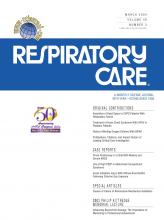Abstract
INTRODUCTION: Portable pressure ventilators, or bi-level ventilators, do not typically have an oxygen control, and thus supplemental oxygen is usually administered by adding it into the mask or the circuit. We conducted this study to test the hypothesis that delivered oxygen concentration using this configuration is affected by the choice of leak port, oxygen injection site, and ventilator settings.
METHODS: A lung model simulating spontaneous breathing was connected to the head of a manikin. An oronasal mask was attached to the manikin. A single-limb circuit was attached to the mask and a bi-level ventilator. Three leak ports were compared: leak in the mask, plateau exhalation valve with mask leak port occluded, and leak port in the circuit with mask leak port occluded. Bi-level positive airway pressure (BiPAP) settings of 10/5, 15/5, 20/5, 15/10, 20/10, and 25/10 cm H2O were used at respiratory rates of 15 and 25 breaths/min. Oxygen was added into the mask or into the circuit at the ventilator outlet, using flows of 5 and 10 L/min. Carbon dioxide was added into the lung model to produce an end-tidal PCO2 of either 40 or 75 mm Hg.
RESULTS: Delivered oxygen concentration was not affected by respiratory rate (p = 0.22) or end-tidal PCO2 (p = 0.74). The oxygen concentration was greater when oxygen was added into the circuit with the leak port in the mask (p < 0.001), whereas oxygen concentration was greater when oxygen was added into the mask with the leak port in circuit (p = 0.005). Oxygen concentration was significantly lower with the leak port in the mask (p < 0.001), with a higher inspiratory positive airway pressure (p < 0.001), and with a higher expiratory positive airway pressure (p < 0.001). The highest oxygen concentration was achieved with oxygen added to the mask, with the leak port in the circuit, and with the lowest settings of inspiratory (10 cm H2O) and expiratory (5 cm H2O) positive airway pressure.
CONCLUSIONS: Delivered oxygen concentration during BiPAP is a complex interaction between the leak port type, the site of oxygen injection, the ventilator settings, and the oxygen flow. Because of this, it is important to continuously measure arterial oxygen saturation via pulse oximetry with patients in acute respiratory failure who are receiving noninvasive ventilation from a bi-level ventilator.
Footnotes
- Correspondence: Dean R Hess PhD RRT FAARC, Respiratory Care, Ellison 401, Massachusetts General Hospital, 55 Fruit Street, Boston MA 02114. E-mail: dhess{at}partners.org.
A version of this report was presented at the American Association for Respiratory Care Open Forum at the 48th International Respiratory Congress, held October 5-8, 2002, in Tampa Bay, Florida.
- Copyright © 2004 by Daedalus Enterprises Inc.







